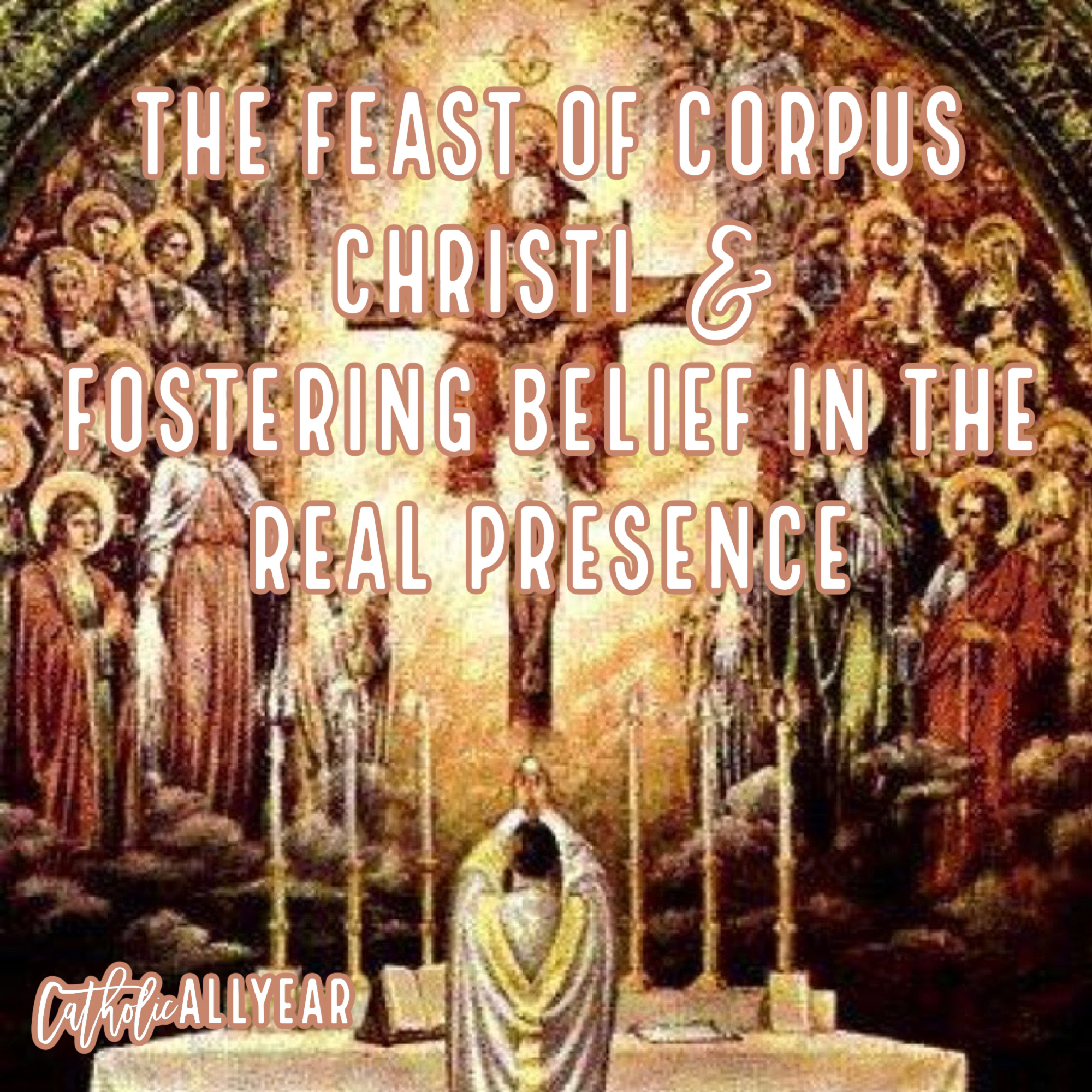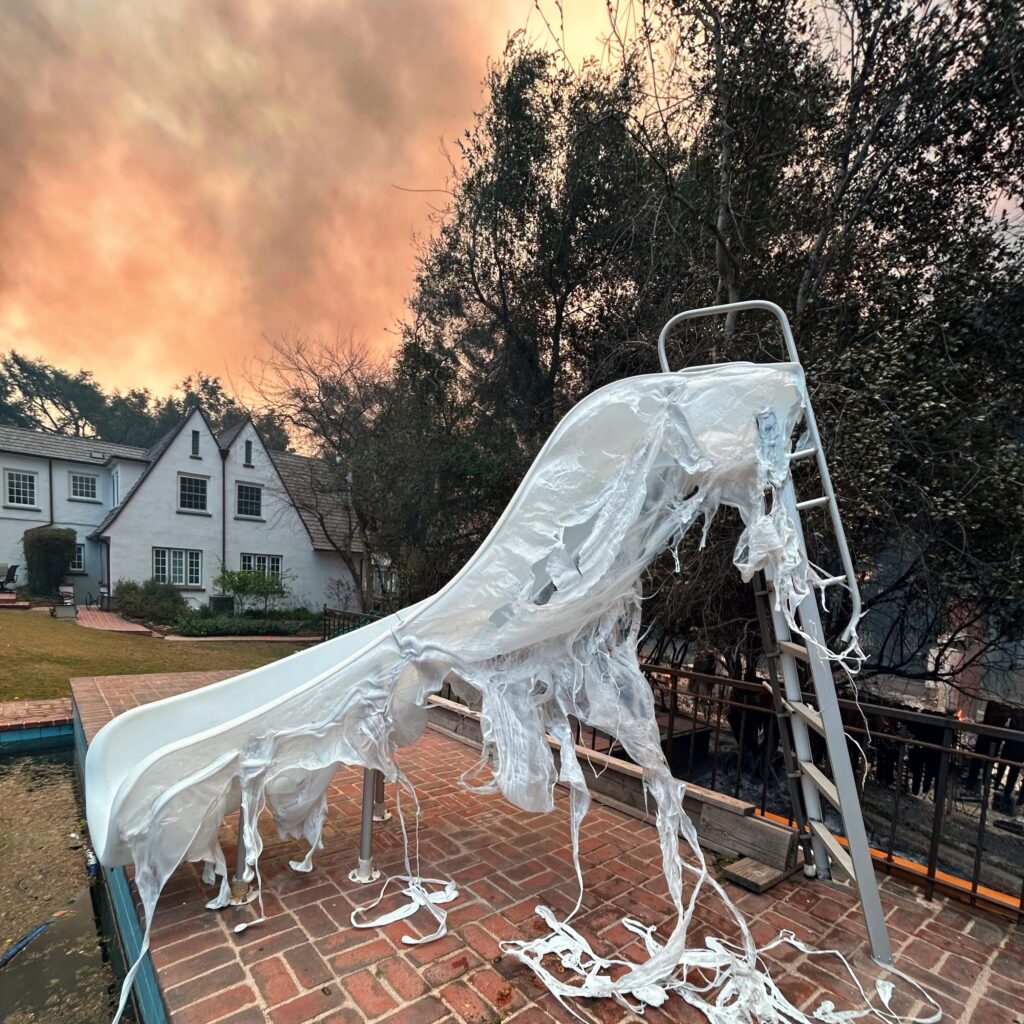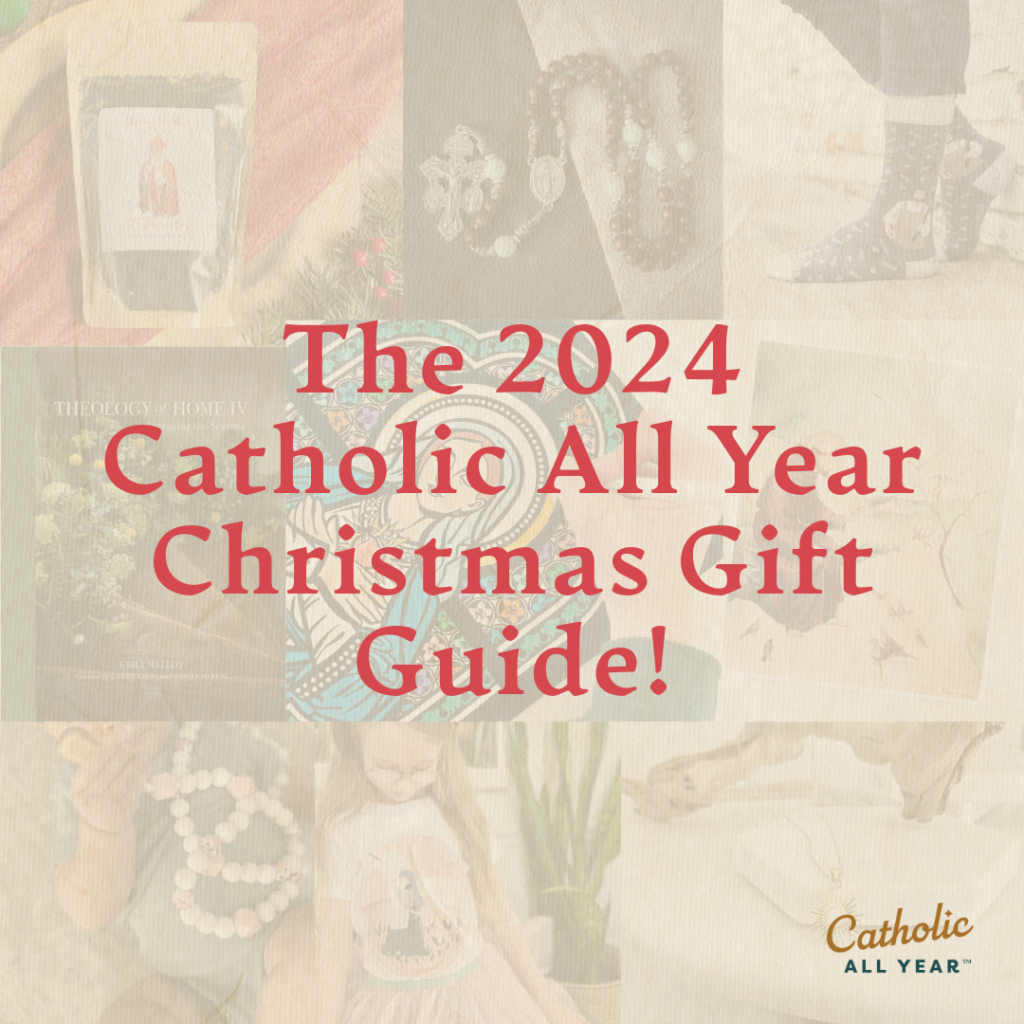Prefer to watch or listen rather than read? This post is available in video format here.
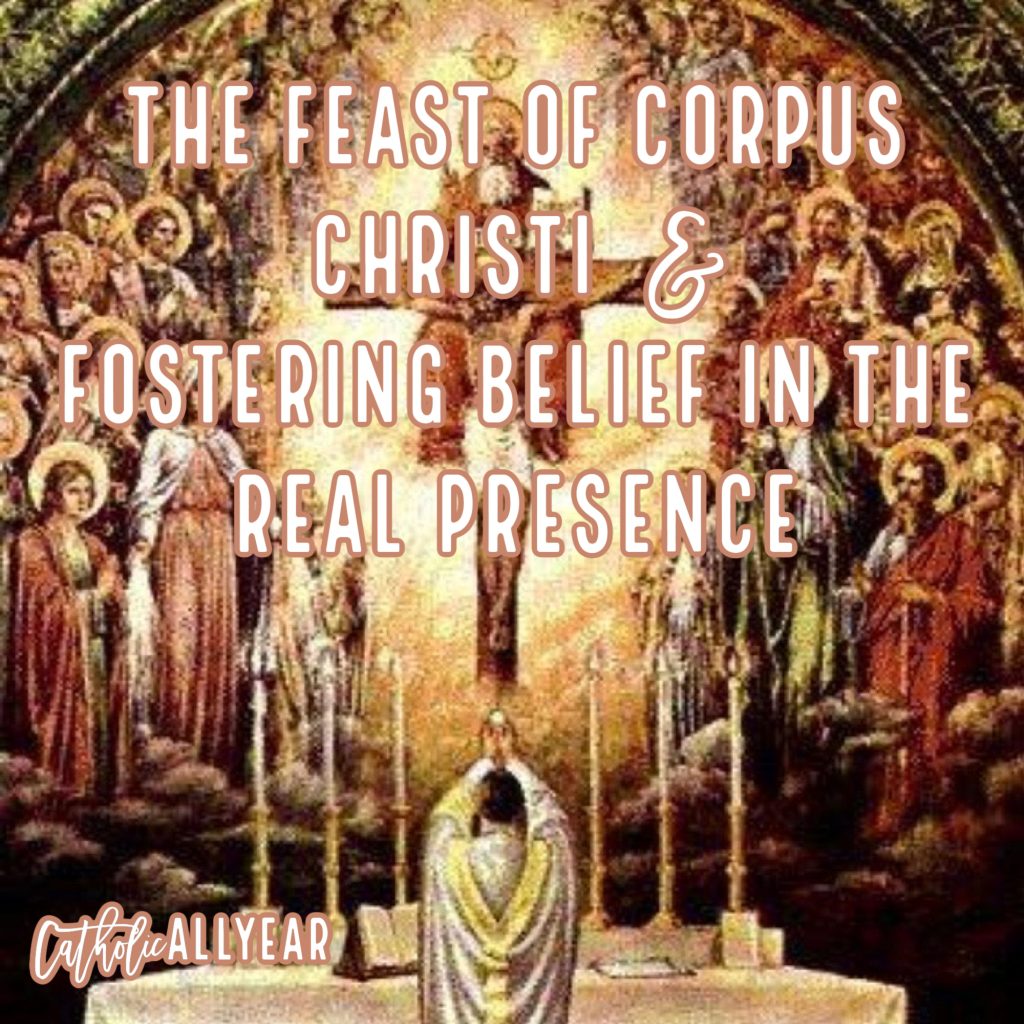
Hey all! Today we’re going to talk about belief in the Real Presence of Jesus in the Eucharist: how to understand it, how to teach it, and how to celebrate its feast day, Corpus Christi, which is observed on June 19th this year.
The Solemnity of the Most Holy Body and Blood of Jesus is also known as Corpus Christi. It’s a solemnity, which means it’s of the highest ranking of the “levels” of feast day, which go, from most to least important: solemnity, feast, memorial, and optional memorial.
Corpus Christi is a movable feast observed the week after Trinity Sunday, eight weeks after we observed Holy Thursday. Corpus Christi is a Thursday feast day, but currently its observance is moved to the following Sunday in the U.S. and most of the world.
If you’re reading this post in 2027 or 2032, please note that Corpus Christi falls at the end of May for you. Otherwise look for it in June.
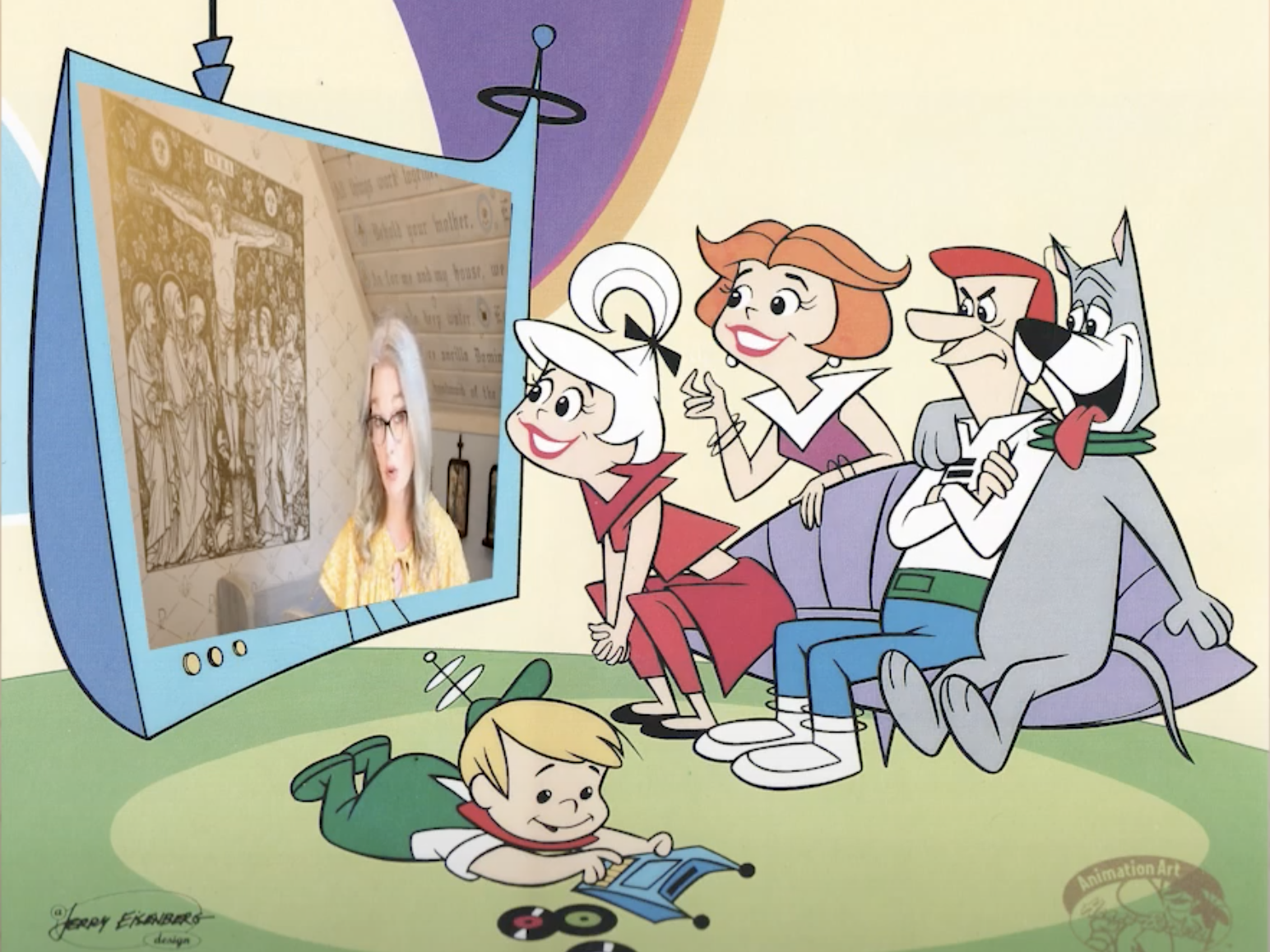
Okay . . . WHAT IS THE FEAST OF CORPUS CHRISTI?
There’s an important relationship between Holy Thursday and Corpus Christi. On Holy Thursday we remember the Institution of the Eucharist by Jesus at the Last Supper.
But we also commemorate so many other events on that day and over the course of the Triduum, that, starting in the thirteenth century, the Church instituted the feast of Corpus Christi as a separate feast day, observed after Pentecost.
Without being tied up in the sorrows of Christ’s passion and death, on the Feast of Corpus Christi we can better rejoice in the extraordinary gift of the Eucharist. Jesus is truly with us and truly present in every tabernacle in every Catholic church in the world. Christ has given to us his body to eat and his blood to drink. It’s humbling and . . . unsettling, right? Jesus’ followers thought the same thing.
In John 6:52-60, we read:
“The Jews then disputed among themselves, saying, ‘How can this man give us his flesh to eat?’ So Jesus said to them, ‘Truly, truly, I say to you, unless you eat the flesh of the Son of man and drink his blood, you have no life in you; he who eats my flesh and drinks my blood has eternal life, and I will raise him up at the last day.
For my flesh is food indeed, and my blood is drink indeed. He who eats my flesh and drinks my blood abides in me, and I in him. As the living Father sent me, and I live because of the Father, so he who eats me will live because of me. This is the bread which came down from heaven, not such as the fathers ate and died; he who eats this bread will live for ever.’ This he said in the synagogue, as he taught at Caper′na-um.
Many of his disciples, when they heard it, said, ‘This is a hard saying; who can listen to it?’”
Unfortunately, the saying hasn’t gotten any easier to accept over the last two thousand years. And now, belief in the real presence of Christ in the Eucharist is something that divides Catholics and Orthodox Christians from some Protestant denominations.
Catholics believe in the concept of transubstantiation. That is, that while the bread and wine continue to have all the appearances of bread and wine (color, shape, taste, calories, gluten etc.) at the consecration their substance is changed completely to actually BE Christ’s body and Christ’s blood.
We read in the Catechism of the Catholic Church #1376:
“The Council of Trent summarizes the Catholic faith by declaring: ‘Because Christ our Redeemer said that it was truly his body that he was offering under the species of bread, it has always been the conviction of the Church of God, and this holy Council now declares again, that by the consecration of the bread and wine there takes place a change of the whole substance of the bread into the substance of the body of Christ our Lord and of the whole substance of the wine into the substance of his blood. This change the holy Catholic Church has fittingly and properly called transubstantiation’”
I love that many parishes have brought back the traditional practice of ringing bells at the moment of consecration. It allows kids and grownups alike to recognize that moment of a real no kidding miracle. My three year old gasps and whispers, “It just HAPPENED.”
WHAT TO DO FOR THE FEAST OF CORPUS CHRISTI
The traditional thing to do for this feast day is a Eucharistic Procession. Pope St. John Paul II encouraged it in 2004, saying:
“This year let us also celebrate with particular devotion the Solemnity of Corpus Christi, with its traditional procession. Our faith in the God who took flesh in order to become our companion along the way needs to be everywhere proclaimed, especially in our streets and homes, as an expression of our grateful love and as an inexhaustible source of blessings.”
If your parish has one, lucky you! Because, unfortunately, this isn’t an observance that has an easy do-it-yourself version. At-home processions are great. We do a lot of them. But a Eucharistic Procession isn’t as fun without the Eucharist.
However, going to Mass, and staying afterwards to spend some time visiting Jesus in the tabernacle afterwards, is also pretty good.
If your church has an adoration chapel, this would be a very good day to start—or continue—a family tradition of staying after Mass for a quick visit there, or before the tabernacle in the main church. We are fortunate enough to attend a church where our friends and our kids’ friends also attend, and we are all in a hurry to get out front and socialize. But there is NOTHING we can do for our kids to make the Real Presence more real to them than to teach them to interact with Jesus in the monstrance and in the tabernacle. To sit with him, to talk with him. We model this ourselves, and we make sure the kids spend a few moments with Jesus, before running out the door.
Another simple habit that acknowledges the divinity of the Most Holy Body and Blood of Christ is to make and say the sign of the cross whenever we walk or drive past a Catholic Church. Even if we don’t have time to stop, making the sign of the cross as we go past reminds us that Jesus is truly there.
Some days, while out running errands or between pickups and drop offs, we ARE able to stop at church and make a visit to the Blessed Sacrament.
Any—seriously ANY—amount of time is great. Even if we just pop in, genuflect (if the Blessed Sacrament is in the tabernacle), or kneel down on two knees (if the Blessed Sacrament is exposed in a monstrance), tell Jesus we love him, and leave.
The recommendation in the Manual of Indulgences is to spend half an hour. I have been known to divide that amount of time by how many little kids I have with me: so, me plus four kids equals six minutes of adoration. But that’s not officially authorized. A (much) better than nothing version with a sleeping baby in the car is to park outside the church or chapel, ideally facing a window, and do a quick visit from inside the car.
On days when we cannot get to Mass to receive communion we can make an Act of Spiritual Communion. This is a prayer that says, basically, that we WISH we could receive communion today, even if we can’t.
I use one recommended by St. Josemaria Escriva, that’s short and sweet. He says: I wish, my Lord, to receive You with the purity, humility and devotion with which Your most holy Mother received You, with the spirit and fervor of the saints.
I have a great affinity for the more unusual, and often only tangentially-related, traditions associated with particular feast days all over the world. There’s a great one for Corpus Christi.
Documented since 1440, the people of Barcelona have honored this feast day with what they call the “dancing egg” in lavishly decorated fountains all over the city. An eggshell is emptied, the holes covered back over with wax, and then it’s balanced on the upward jet of water from the fountain, where it merrily “dances”.
The fountains are decorated with flowers and fruit. There’s not a great consensus on what exactly this has to do with the Eucharist, but, hey, I’m here for it. We don’t have a fountain at my house. But we’ve got a hose, and plenty of kids who would probably be willing to try to hold it straight, or maybe I’ll ask Fr. Gonzales if we can try it in the fountain in the courtyard at church. Creating a centerpiece for the dinner table of fresh flowers and fruit is another way to bring this tradition home.
WHAT TO PRAY FOR THE FEAST OF CORPUS CHRISTI
We like to recite or sing the prayer traditionally associated with the feast of Corpus Christi on this day: Tantum Ergo. It’s the last two stanzas of the Pange Lingua, a eucharistic hymn composed by St. Thomas Aquinas.
WHAT TO EAT FOR THE FEAST OF CORPUS CHRISTI
Because of the relation of this Feast to Holy Thursday, similar foods would be appropriate on this day. Our family tradition for Holy Thursday is to make a modified Last Supper meal of lamb, flat bread, and bitter herbs, plus, just for fun, a big rice crispy treat lamb cake.
Another option is baking bread at home. I like to use feast days as an opportunity to introduce or practice various “life-skills”. Baking bread is one particularly close to my heart. I didn’t grow up in a home with a focus on cooking or baking, and when I got married at twenty-four, I had pretty much zero homemaking skills.
I once asked a neighbor if I could borrow grated cheese because it didn’t occur to me that I could, myself, create grated cheese from a block of cheese. I was just used to grated cheese coming from a bag!
So learning to bake bread myself felt like a real accomplishment. I don’t do it regularly, but I CAN do it, and I think it’s a great and meaningful family activity for this feast day. It, of course, won’t be the same as the Eucharist, but making it together and having it on the table opens the door to that conversation.
And those conversations are why we do this. So get out there and celebrate the feast of Corpus Christi.
If you want to learn more about celebrating feast days, check out my books The Catholic All Year Compendium, and The Catholic All Year Prayer Companion.
Catholic All Year Members have access to the print-and-go membership library with prayer, hymn, recipes, and decor for hundreds of feast days, and Catholic All Year Subscription Boxes will deliver liturgical living essentials to your doorstep every month.
I hope you’ll give it a try! Catholic All Year is here to help.

PS: Father’s Day is 9 days away! Have you ordered your gift yet?!

